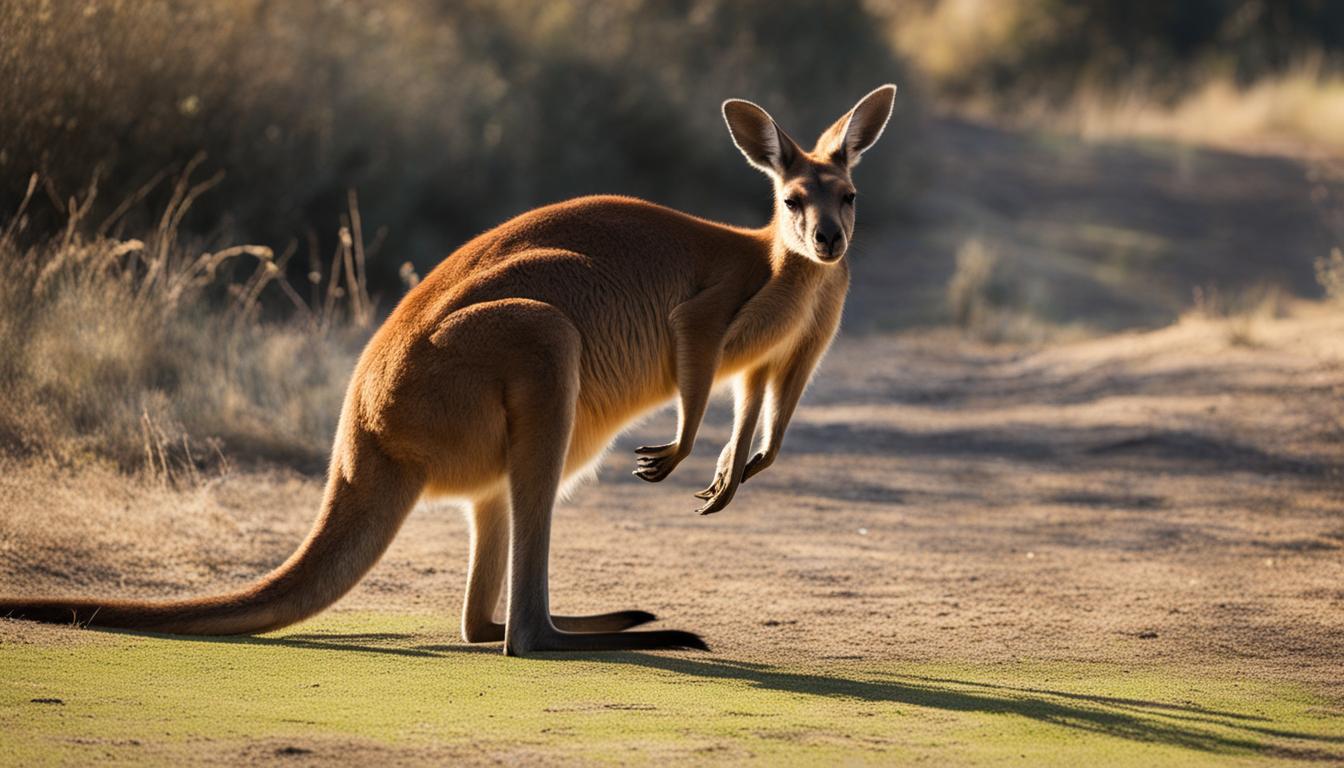Welcome to our fascinating exploration of kangaroo mating habits, reproductive behavior, and breeding cycles. In this article, we will delve into the enchanting world of kangaroo courtship and uncover the unique strategies these iconic Australian creatures employ to ensure reproductive success.
Before we dive into the details, let’s take a moment to appreciate the beauty of these incredible animals. Here’s an image of a kangaroo in its natural habitat:
Kangaroos, unlike many other species, do not have a specific breeding season. They have the remarkable ability to breed all year round, making their mating habits a constant occurrence. Male kangaroos, known as bucks, spend days courting females, engaging in a variety of behaviors that signal their readiness to mate.
Throughout the courtship ritual, bucks can sense a female’s receptiveness through smell and stay close, guarding her from potential competitors. The courting process involves tail stroking, affectionate grazing, and other endearing gestures that build a connection between the pair.
Courtship and Mating Behaviors of Kangaroos
Kangaroos engage in fascinating courtship rituals before mating. Male kangaroos, or bucks, display various behaviors to attract and court female kangaroos, or does. These courtship behaviors are essential for reproductive success and ensuring the continuation of their species.
During the kangaroo mating season, bucks will approach the does in a non-aggressive manner. They sniff the female’s cloacal region, which helps them determine if she is receptive to mating. This behavior allows the male to gauge the female’s reproductive status and readiness to conceive.
Once a buck identifies a receptive female, he may exhibit courtship displays such as grasping and stroking the female’s tail, making soft clucking sounds, and touching or grasping her head. These actions are part of the courtship ritual that helps establish a connection between the male and female kangaroo.
Male kangaroos have a unique way of clasping the female’s body during mating. The male uses his forearms to hold the female’s waist from behind, ensuring a secure connection for copulation. This position can last for 10 to 15 minutes, during which the male deposits his sperm into the female’s reproductive tract, increasing the chances of successful fertilization.
The courtship and mating behaviors of kangaroos exemplify the complexity and adaptability of these iconic Australian creatures. By understanding their mating rituals, scientists gain valuable insights into the reproductive strategies employed by kangaroos, contributing to our knowledge of their unique behaviors and biology.
Table: Comparison of Courtship Behaviors in Kangaroo Species
| Kangaroo Species | Approach | Courtship Displays | Mating Position |
|---|---|---|---|
| Red Kangaroo | Sniffing cloacal region and pouch opening | Minimal touching or grasping of uninterested females | Male pulls female back on his penis |
| Eastern Grey Kangaroo | Sniffing cloacal region | Head touching and grasping tail | Male clasps female around the waist from behind |
| Western Grey Kangaroo | Sniffing cloacal region | Head touching and grasping tail | Male clasps female around the waist from behind |
The table compares courtship behaviors in different kangaroo species, highlighting variations in approach, courtship displays, and mating positions. This information helps us appreciate the diversity within the kangaroo family and how different species have evolved distinct strategies for courtship and reproduction.
Mating habits of red kangaroos
The red kangaroo, the largest kangaroo species, exhibits unique courtship and mating behaviors. Unlike other species, red kangaroos have a less complex courtship ritual. The male approaches the female and sniffs her cloacal region and pouch opening to determine her receptiveness. If the female is unreceptive, she may move away, and the male rarely touches or grasps her. However, if the female is receptive, the male follows her closely and grasps her tail as part of the mating sequence.
The male red kangaroo may also perform the “flehmen” response, which involves sniffing the female’s urine to detect pheromones and determine her reproductive status. Mating can be interrupted by aggressive interference from other males, highlighting the competitive nature of red kangaroo mating behavior.
Overall, the mating habits of red kangaroos are characterized by simple courtship activities and a mating sequence involving the male’s tail grasping and possible interference from other males. Understanding these mating behaviors contributes to our knowledge of the reproductive strategies employed by red kangaroos to ensure successful mating and genetic diversity within their population.
| Red Kangaroo Mating Behaviors | Description |
|---|---|
| Tail grasping | The male red kangaroo follows and grasps the female’s tail as part of the mating sequence. |
| Flehmen response | The male red kangaroo performs the flehmen response by sniffing the female’s urine to determine her reproductive status. |
| Aggressive interference | Other males may aggressively interfere with mating attempts, potentially interrupting the mating process. |
In conclusion, the mating habits of red kangaroos differ from those of other kangaroo species, with simpler courtship activities and tail grasping during mating. These behaviors are influenced by the male’s assessment of the female’s receptiveness and her reproductive status. Mating can be hindered by aggressive interference from competing males. Further research into the reproductive strategies of red kangaroos can provide valuable insights into the dynamics of their populations and the conservation of their genetic diversity.
Reproductive Strategies of Kangaroos
Kangaroos employ various reproductive strategies to ensure their reproductive success. One prominent strategy involves dominant males having the right to mate with females in a group. However, subordinate males may attempt to mate with females when the dominant male is not looking. This behavior prevents inbreeding and helps mix up the gene pool of the group, ensuring genetic diversity.
Female kangaroos also play a role in reproductive strategies by extending their area of activity as estrus approaches. This behavior attracts the largest male available, increasing the chances of reproductive success. It showcases the kangaroo’s ability to assess its environment and make strategic decisions to optimize its reproductive opportunities.
The reproductive strategies of kangaroos also highlight the importance of size in sexual selection. Larger dominant males may have higher feeding requirements, leading them to choose survival over breeding during poor conditions. They often move to areas with better feed, leaving breeding opportunities for smaller males. This strategy allows dominant males to secure their survival and indirectly contribute to reproductive success by maintaining the overall health of the group.
Table: Comparative Reproductive Strategies of Kangaroo Species
| Kangaroo Species | Reproductive Strategy |
|---|---|
| Red Kangaroo | Males approach females, sniff cloacal region and pouch opening. Grasping of tail is involved in the mating process. |
| Eastern Grey Kangaroo | Males engage in courtship behaviors such as sniffing, clucking, and stroking the female’s tail. They mate when the female is about to ovulate, clasping her body with their forearms. |
| Western Grey Kangaroo | Males follow females and grasp their tail. Copulation involves pulling the female back on the male’s penis. |
The diverse reproductive strategies of kangaroos contribute to their overall reproductive success. By understanding and studying these strategies, researchers gain valuable insights into the complex dynamics of sexual selection and breeding behaviors in the animal kingdom.
Note: The table above provides a comparative overview of the reproductive strategies observed in different kangaroo species.
Conclusion
Kangaroos have fascinating mating habits and reproductive behaviors. They can breed all year round, allowing for a continuous breeding cycle. The courtship rituals of kangaroos involve tail stroking, affectionate grazing, and other displays of affection. Males spend significant time courting females, ensuring the right timing for mating.
During mating, the male kangaroo clasps the female’s body with his forearms, initiating copulation. Different species of kangaroos exhibit various courtship and mating behaviors, with red kangaroos having less complex courtship activities compared to others. The goal of these mating habits is reproductive success, ensuring the continuation of their population.
Understanding kangaroo mating habits provides insights into their unique reproductive strategies and behaviors. By studying their reproductive behavior, scientists can gain a deeper understanding of their breeding cycles and the factors that contribute to their successful reproduction. As we continue to learn more about these incredible creatures, we gain a greater appreciation for their fascinating mating rituals.
How does the mating behavior of kangaroos contribute to their reproduction in the wild?
During the mating season for kangaroos, males often engage in competitive behaviors to attract females. This can include boxing matches and displays of dominance. Once a female selects a mate, she will give birth to a single offspring after a short gestation period, and then become ready to mate again.
FAQ
Do kangaroos have a specific breeding season?
No, kangaroos can breed all year round.
How do male kangaroos court females?
Male kangaroos court females by sniffing their cloacal region and approaching them in a non-aggressive manner. They may also stroke the female’s tail and cluck softly.
How long does mating typically last for kangaroos?
Mating can last from a few minutes to 10 minutes or more.
What are the courtship behaviors of red kangaroos?
Red kangaroos engage in courtship behaviors such as sniffing the female’s cloacal region and pouch opening. The male may grasp and stroke the female’s tail, and the full mating sequence includes approaching, sniffing, moving off, and grasping the tail.
What happens if a female kangaroo is uninterested?
If a female kangaroo is uninterested, she may move away, and the male rarely touches or grasps her.
How do kangaroos ensure genetic diversity in their groups?
Dominant males have the right to mate with females, but subordinate males may attempt to mate when the dominant male is not looking. This helps mix up the group’s gene pool and prevents inbreeding.
Do kangaroos have a specific mating season?
No, kangaroos can mate all year round.
What is the goal of kangaroo mating behaviors?
The ultimate goal of kangaroo mating behaviors is to ensure reproductive success and the survival of their species.










